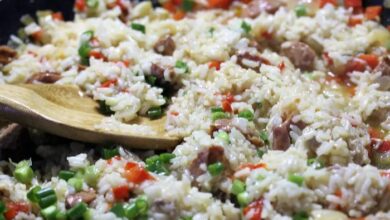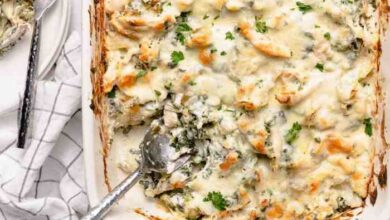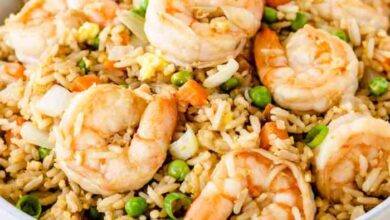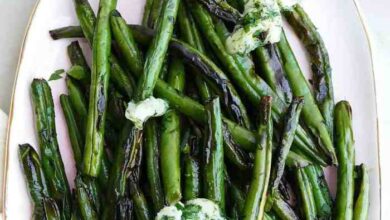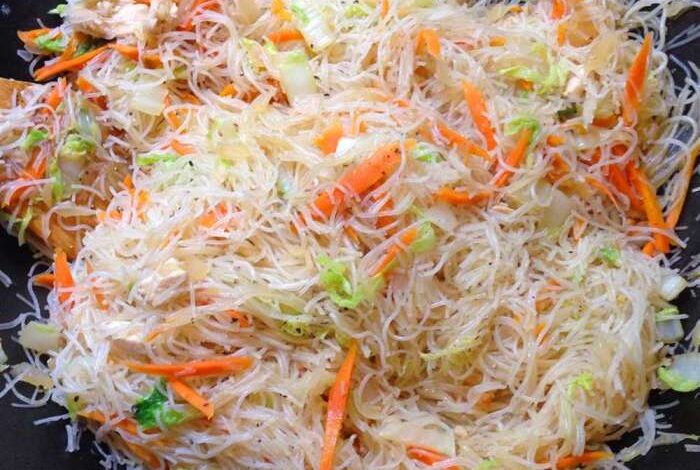
Quick and Easy Pancit: A Taste of Filipino Comfort Food
Quick and easy pancit is a delicious and versatile Filipino dish that’s perfect for any occasion. Whether you’re looking for a quick weeknight meal or a crowd-pleasing recipe for a party, pancit is always a hit. This noodle dish comes in many variations, each with its own unique flavor and texture.
The history of pancit is rich and fascinating, with roots in Chinese cuisine and a long tradition in the Philippines.
Pancit is a true testament to Filipino culinary ingenuity, a dish that has evolved over centuries to become a beloved staple. From its humble origins to its modern-day variations, pancit continues to capture the hearts and stomachs of Filipinos and food enthusiasts alike.
The beauty of pancit lies in its adaptability, allowing you to create your own personal masterpiece by incorporating your favorite ingredients and flavors.
Introduction to Quick and Easy Pancit
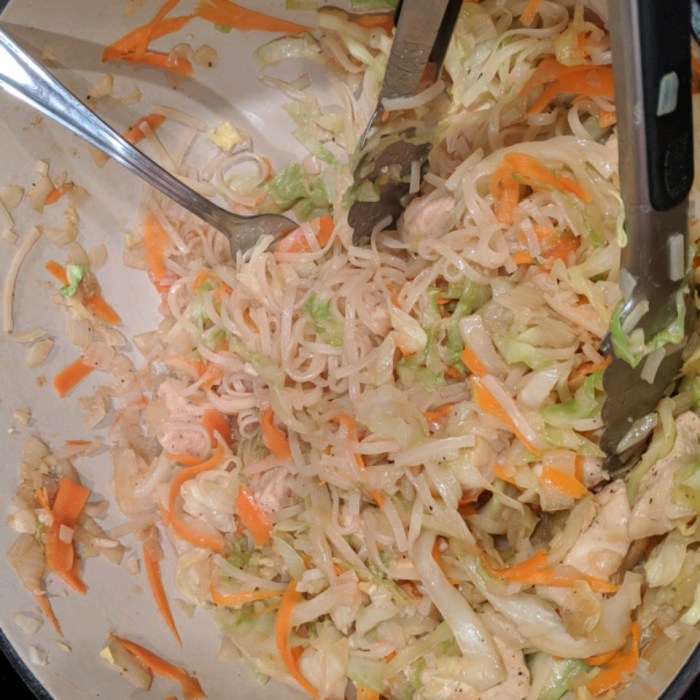
Craving a delicious and comforting Filipino dish but don’t have hours to spend in the kitchen? Look no further than quick and easy pancit recipes! These convenient and flavorful dishes are perfect for busy weeknights, impromptu gatherings, or even just a satisfying lunch.
Pancit, a noodle dish that’s a staple in Filipino cuisine, is known for its versatility and adaptability, making it a popular choice for both home cooks and professional chefs.Pancit is more than just a meal; it’s a symbol of Filipino culture and tradition.
Its history dates back centuries, with different varieties emerging across the archipelago. Each region has its own unique pancit recipe, reflecting the diverse flavors and culinary traditions of the Philippines.
The Versatility of Pancit
The beauty of pancit lies in its adaptability. It can be prepared with various types of noodles, ranging from thin rice noodles to thicker wheat noodles, and can be seasoned with a wide array of ingredients. Whether you prefer a simple stir-fry with vegetables or a more elaborate dish with meat and seafood, there’s a pancit recipe for every taste and occasion.
Quick and easy pancit is a lifesaver when you need a comforting meal on the table fast. It’s all about those simple, satisfying flavors. Sometimes, though, I crave something a little more refreshing and tangy, like a key lime poke cake.
But when it comes to weeknight dinners, I’ll always come back to pancit – it’s just too easy to whip up and always hits the spot.
The Cultural Significance of Pancit
Pancit holds a special place in Filipino culture. It’s often served at celebrations, birthdays, and special occasions, symbolizing long life and prosperity. The dish’s noodles are said to represent longevity, making it a popular choice for birthdays and other celebratory events.
“Pancit is more than just a dish; it’s a cultural symbol that represents Filipino identity and heritage.”
The cultural significance of pancit is evident in the numerous sayings and traditions associated with it. For instance, the phrase “Kapag may pancit, may handaan” (When there’s pancit, there’s a celebration) highlights the dish’s connection to joyous occasions.
Key Ingredients for Quick and Easy Pancit
Pancit, a beloved Filipino noodle dish, is known for its versatility and adaptability. Its simplicity lies in its core ingredients, which can be easily customized to suit individual preferences and regional variations.
Sometimes, when I’m craving something comforting and familiar, I whip up a quick and easy pancit. It’s a dish that always brings back happy memories of family gatherings. But for a truly decadent treat, nothing beats the tangy sweetness of the best lemon tart ever.
It’s the perfect balance of creamy, tart, and buttery, and a great way to end a meal. But back to the pancit, it’s just so versatile, you can add all sorts of veggies and protein to make it your own.
The key ingredients for a basic pancit recipe are:
Basic Pancit Ingredients
- Noodles:Pancit noodles are the foundation of the dish. These noodles come in various forms, each contributing a distinct texture and flavor. Popular choices include:
- Pancit Canton:Thin, flat noodles that are typically used in stir-fried pancit dishes. They offer a light and chewy texture.
- Pancit Bihon:Fine, thin rice noodles that are commonly used in soups and stews. They provide a delicate and slightly sticky texture.
- Pancit Habhab:Thick, flat noodles that are often served with a savory sauce. They have a hearty and substantial texture.
- Vegetables:Vegetables add color, freshness, and nutritional value to pancit. Common choices include:
- Cabbage:Provides a crunchy texture and a slightly sweet flavor.
- Carrots:Adds a vibrant orange color and a mildly sweet taste.
- Green Beans:Offer a crisp texture and a fresh, earthy flavor.
- Onions:Provide a pungent flavor and a savory aroma.
- Garlic:Adds a distinct aroma and a pungent flavor.
- Meat:Meat is often incorporated to add protein and flavor. Popular options include:
- Pork:A versatile meat that can be sliced, ground, or shredded.
- Chicken:Offers a lean protein source with a mild flavor.
- Shrimp:Adds a delicate sweetness and a seafood flavor.
- Sauce:The sauce is crucial for binding the ingredients and creating a flavorful base. Common sauce options include:
- Soy Sauce:Provides a salty and savory flavor.
- Fish Sauce:Adds a unique umami flavor.
- Oyster Sauce:Offers a rich, savory flavor with a slight sweetness.
- Seasonings:Seasonings enhance the overall flavor profile of the dish. Popular choices include:
- Salt:Balances the flavors and adds a savory note.
- Pepper:Provides a spicy kick.
- Sugar:Adds a touch of sweetness to balance the savory flavors.
Regional Variations, Quick and easy pancit
Pancit is a diverse dish with numerous regional variations, each showcasing unique ingredients and flavor profiles. For example, in the Philippines, there are several regional variations of pancit, such as:
- Pancit Batil Patong:Originating from Batangas, this pancit features thin rice noodles, shrimp, pork, vegetables, and a savory sauce.
- Pancit Molo:A popular dish from Ilocos, this pancit features thin rice noodles, pork dumplings, and a flavorful broth.
- Pancit Habhab:Originating from the Bicol region, this pancit features thick flat noodles, shrimp, pork, vegetables, and a spicy sauce.
These regional variations highlight the versatility of pancit and its ability to adapt to different tastes and preferences.
Quick and easy pancit is a staple in my kitchen, perfect for busy weeknights. I love adding a tangy kick to my pancit with a homemade vinegar-based BBQ sauce, and I’ve found a great recipe on Cerita Kuliner that really elevates the dish.
The sweet and smoky flavors of the sauce complement the noodles and vegetables beautifully, making this simple dish even more satisfying.
Quick and Easy Pancit Recipe Variations
Pancit, a beloved Filipino noodle dish, is known for its versatility. The basic recipe can be easily adapted to create a variety of flavors and textures. This section explores different variations of quick and easy pancit recipes, from classic to innovative.
Classic Quick and Easy Pancit Recipe
This recipe provides a basic foundation for a quick and easy pancit dish.
Ingredients:
- 1 package (12 ounces) pancit noodles (such as bihon, miki, or sotanghon)
- 1 tablespoon vegetable oil
- 1/2 cup chopped onion
- 1/2 cup chopped garlic
- 1/2 cup chopped carrots
- 1/2 cup chopped cabbage
- 1/2 cup chopped green beans
- 1/4 cup soy sauce
- 1/4 cup chicken broth
- 1/4 cup oyster sauce
- 1/4 teaspoon black pepper
- 1/4 cup chopped green onions
Instructions:
- Cook the pancit noodles according to package directions. Drain and set aside.
- Heat the oil in a large skillet or wok over medium heat.
- Add the onion, garlic, carrots, cabbage, and green beans and cook until softened, about 5 minutes.
- Stir in the soy sauce, chicken broth, oyster sauce, and black pepper. Bring to a simmer.
- Add the cooked noodles and toss to coat.
- Serve immediately, garnished with chopped green onions.
Pancit Variations
The classic pancit recipe can be adapted with different noodles, vegetables, and protein sources.
Noodle Variations
- Bihon: Thin rice noodles that are commonly used in pancit recipes. They have a delicate texture and absorb flavors well.
- Miki: Egg noodles that are thicker than bihon. They have a slightly chewy texture and are often used in pancit dishes with a richer sauce.
- Sotanghon: Cellophane noodles that are made from mung bean starch. They have a translucent appearance and a soft, slippery texture.
Vegetable Variations
- Bok choy: A leafy green vegetable with a mild flavor that complements the noodles.
- Mushrooms: Shiitake or button mushrooms add a savory and earthy flavor.
- Bell peppers: Red, yellow, or green bell peppers add color and sweetness to the dish.
Protein Variations
- Chicken: Shredded or diced chicken adds a protein boost and a savory flavor.
- Pork: Thinly sliced pork belly or ground pork adds richness and flavor.
- Shrimp: Shrimp adds a delicate sweetness and a seafood flavor.
Pancit Types and Unique Ingredients
Different types of pancit are characterized by their unique ingredients and flavor profiles.
| Pancit Type | Unique Ingredients | Flavor Profile |
|---|---|---|
| Pancit Canton | Egg noodles, shrimp, pork, vegetables, and a sweet and savory sauce | Sweet, savory, and slightly salty |
| Pancit Palabok | Thick rice noodles, shrimp, pork, and a rich, orange-colored sauce made with annatto seeds | Savory, spicy, and slightly tangy |
| Pancit Bihon Guisado | Thin rice noodles, vegetables, and a savory sauce | Savory, slightly salty, and umami-rich |
Tips for Making Quick and Easy Pancit
This quick and easy pancit recipe is designed for convenience, but there are still some tips and tricks to ensure the best possible results. Here are some tips to help you make the perfect pancit, every time.
Cooking the Noodles Perfectly
Cooking the noodles perfectly is crucial for a good pancit. Overcooked noodles become mushy and lose their texture, while undercooked noodles are tough and unpleasant to eat. Here are some tips to ensure your noodles cook perfectly:
- Follow the package directions for cooking time. Most pancit noodles require about 3-5 minutes of cooking time.
- Use a large pot with plenty of water. This will help ensure the noodles cook evenly and don’t stick together.
- Add a tablespoon of oil to the water to prevent the noodles from sticking together.
- Don’t overcook the noodles. Once they are cooked through, drain them immediately and rinse them with cold water to stop the cooking process.
Achieving the Ideal Sauce Consistency
The sauce is what brings the flavors together in pancit. It should be thick enough to coat the noodles but not too thick that it becomes clumpy. Here are some tips to help you achieve the ideal sauce consistency:
- Use a combination of cornstarch and water to thicken the sauce. Cornstarch is a common thickener in Asian cooking and creates a smooth and glossy sauce.
- Add the cornstarch slurry slowly to the sauce, stirring constantly to prevent lumps from forming.
- Bring the sauce to a simmer and cook for a few minutes until it thickens.
Incorporating Fresh Ingredients
Fresh ingredients add a burst of flavor and texture to pancit. Here are some tips for incorporating fresh ingredients:
- Add chopped vegetables like cabbage, carrots, onions, and garlic to the pancit. These vegetables add sweetness, crunch, and depth of flavor to the dish.
- Use fresh herbs like cilantro, chives, or parsley to garnish the pancit. These herbs add a refreshing touch and enhance the overall flavor.
- For a more flavorful pancit, add fresh shrimp, chicken, or pork. These protein sources add a rich and savory element to the dish.
Serving and Enjoying Quick and Easy Pancit
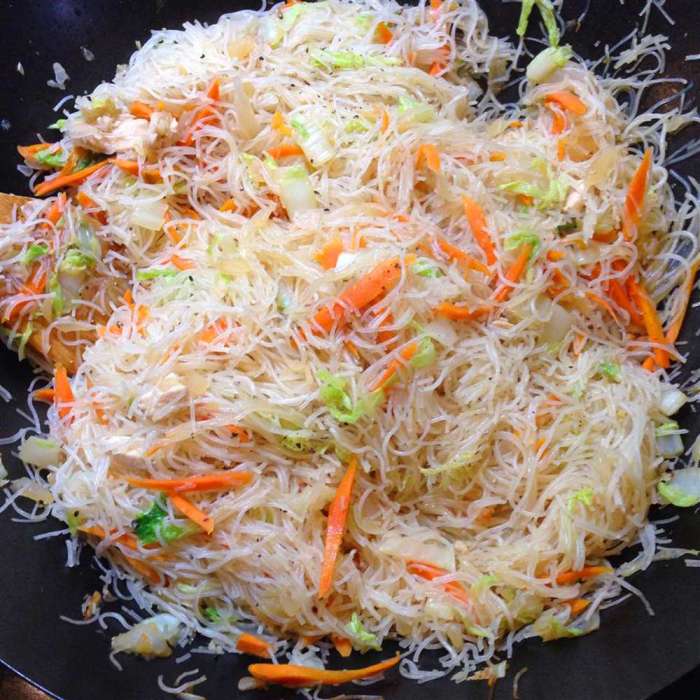
Pancit, a beloved Filipino noodle dish, is not just about its delicious flavors but also about the joy of sharing it with loved ones. Serving pancit is an experience, a celebration of culture and community.
Traditional Serving Methods
Traditionally, pancit is served on large platters or in individual bowls. This allows everyone to share and enjoy the dish together. The noodles are typically tossed with the sauce and toppings, and then arranged artfully on the platter.
Accompanying Dishes and Sides
Pancit is often served with other Filipino dishes, creating a well-rounded meal. Some popular accompanying dishes include:
- Adobo:A classic Filipino dish of pork or chicken braised in soy sauce, vinegar, garlic, and peppercorns.
- Lechon:Roasted suckling pig, a festive dish often served at special occasions.
- Sinigang:A sour and savory soup made with tamarind, vegetables, and meat or seafood.
Sides that complement pancit include:
- Rice:A staple in Filipino cuisine, rice is often served alongside pancit to soak up the delicious sauce.
- Fresh Salad:A refreshing counterpoint to the richness of pancit.
- Pickled Vegetables:A tangy and crunchy addition to the meal.
Cultural Significance of Pancit
Pancit holds a special place in Filipino culture and is often served at celebrations and gatherings. The long noodles symbolize longevity and good fortune, making it a popular dish for birthdays, weddings, and other special occasions.
“Pancit is more than just a dish; it’s a symbol of togetherness and a celebration of life.”
In some regions, specific types of pancit are associated with different celebrations. For example, pancit palabok is often served at birthdays, while pancit canton is a popular choice for weddings.


